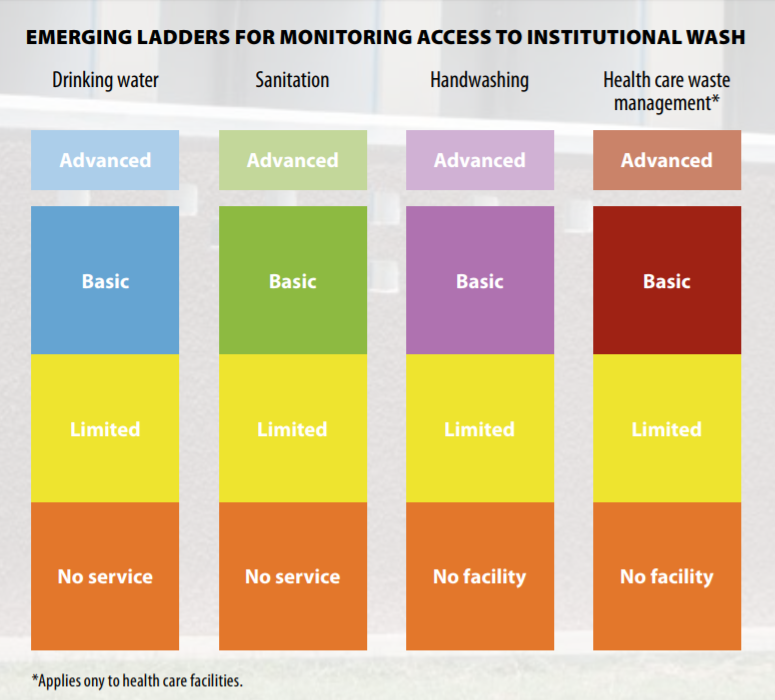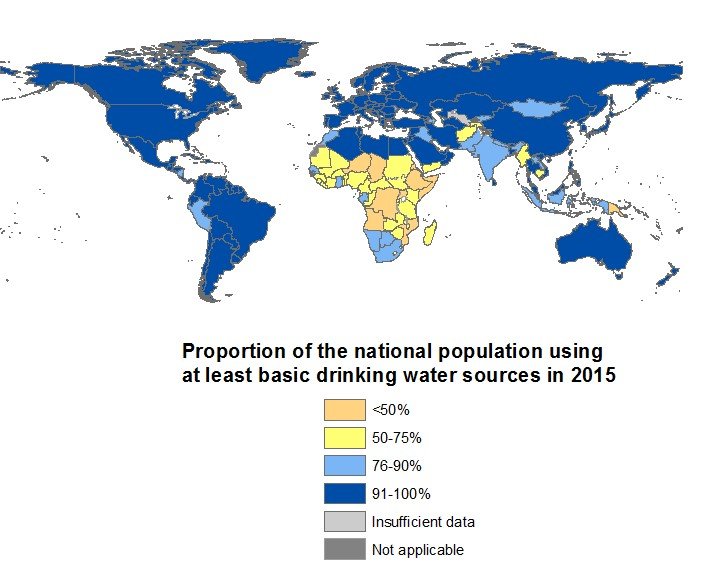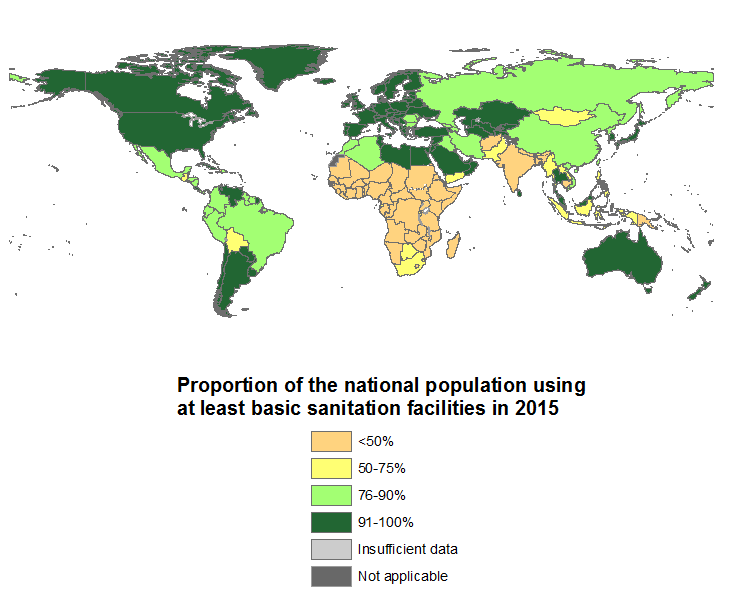Soap, clean drinking water, and bathroom facilities. Most people take them for granted. But across the world, billions still have little to no access to their most basic sanitation needs.
A new report by the World Health Organization and UNICEF shows how even though progress has been made between 2000 and 2015, a lot of work still has to be done to ensure everyone has equal access to clean water and sanitation.
Many regions have made significant progress during this time period, but others have seen deteriorations in water, sanitation, and hygiene (WASH) standards.
Take Action: Tell World Leaders: Provide Access to Sanitation for all
"Much progress has been made on improving sanitation and hygiene conditions around the world," said Chris Williams, Executive Director of the Water Supply and Sanitation Collaborative Council. "However, there is still an urgent global sanitation crisis leaving 2.3 billion people without any form of sanitation. We simply cannot wait to take action.”
The team behind the report measures how countries’ WASH standards are progressing using a system modelled on a ladder and informed by the Sustainable Development Goals.
Read More: Why WASH Is as Important as Books in Schools
Each ladder represents a WASH issue, and each “rung” on each ladder represents the degree of availability. The highest rungs represent ideal standards, and the bottom rungs represent poor standards.
So, for example, the top rung for “water” would be easy access to clean water, whereas the bottom rung would represent unsafe water that’s hard to get.

Countries are not, however, expected to meet the all global goals set by the system. Instead, countries are expected to set their own goals after taking into account both the global standards and unique circumstances of their country.
“It is time that politicians and decision-makers in the health sector recognize the importance of sanitation and hygiene, which are critical enablers of health, social and economic development in the poorest and most marginalized corners of the world," Williams said.
Below is a summary of the report’s key findings regarding drinking water, sanitation, and handwashing.
Drinking Water
Between drinking water, sanitation, and hygiene, access to safely managed drinking water (meaning drinking water located on site, available when needed, and free from contamination) saw the most improvement among individual nations.
But there are still millions of people without access to safe drinking water.
Read More: Trump Looks to Undo Regulation Meant to Protect Water for 117 Million People
Although 71% of the world’s population have access to safe drinking water, 161 million people are using surface water (water directly from rivers, dams, ponds, etc.) as their water source.
There are also 264 million people traveling 30 minutes or more to collect drinking water.

Most Improved Nations:
Mauritania and Bhutan made the most significant improvements in this category.
Bhutan, a small Himalayan country, increased the percentage of its population that has access to basic drinking water by 17% between 2000 and 2015. They also decreased the percentage of people using surface water from 11% to nearly none.
Like Bhutan, Mauritania, located in the western region of Africa, decreased surface water usage to nearly zero in 2015 from 6% in 2000. The country also increased access to basic drinking water from 54% to 70%.
Least Improved Nations:
Zimbabwe and Comoros each saw a decline in access to at least basic drinking water between 2000 and 2015.
Not only did the percentage of Zimbabwe’s citizens who had access to basic drinking water drop from 70% to 67%, the percentage using surface water increased from 6% to 7% between 2000 and 2015.
Comoros, a small island off the east coast of Africa, dropped from 86% of its population having access to basic drinking water in 2000 to 84% in 2015. The nation did, however, improve the number of people drinking from surface sources. The percentage dropped from 2% to 1% by 2015.
Sanitation
Sanitation is one of the most important aspects of WASH as lack to sanitation facilities can lead to contaminated water and disease.
In 2015, 39% of the global population had access to safely managed sanitation services (sanitation facilities not shared with other households where feces is safely disposed of on-site or treated off-site).
Read More: Beyoncé’s #BeyGood4Burundi Campaign Will Bring Clean, Safe Water To Burundi
Despite that seemingly impressive number, 892 million people worldwide still practice open defecation (disposal of human waste in open areas such as fields, forests, bodies of water, etc) because they do not have access to sanitation services of any kind.

Most Improved Nations:
By 2015, both Bangladesh and Honduras saw significant declines in the number of people practicing open defecation.
Even more incredible than 47% of Bangladesh’s population having access to basic sanitation services in 2015 (up from 25% in 2000), is how the nation almost eliminated open defecation in 2015.
Between 2000 and 2015, Honduras increased the amount of people with access to basic sanitation services from 62% to 80%, in addition to lowering open defection to 7%.
Although that progress is impressive, hopefully Honduras will follow Bangladesh in eliminating open defecation.
Least Improved Nations:
Equatorial Guinea and Grenada each saw an increase in the percentage of people practicing open defecation between 2000 and 2015.
Between 2000 and 2015 Equatorial Guinea, a Central African country, regressed both in access to sanitation services, dropping from 80% to 75%, and percentage of people practicing open defecation, which rose from almost none to a monumental 4%.
Like Equatorial Guinea, Grenada saw an increase in open defecation from nearly none to 4% in 2015. However, this Caribbean nation had an even worse plummet in access to basic sanitation services, down to 78% in 2015 from 94% in 2000.
Handwashing
Like sanitation, proper handwashing is essential for preventing the spread of disease and infection. The issue is so important, that JMP decided, for the first time, to collect data on accessibility to hand washing facilities in 2015.
The report found that in the world’s least developed nations, 27% of populations have access to handwashing facilities that include soap and water, but 47% had access to no facility at all.
Interestingly enough, the report also found that many high-income countries lacked sufficient data to estimate the population with basic handwashing facilities.

Nations With Best Handwashing Facilities in 2015:
In Turkmenistan, an impressive 98% of the population had access to basic handwashing facilities that included soap and water.
Not far behind is Bosnia and Herzegovina. This country located on the Balkan Peninsula had access to basic handwashing facilities for 97% of its population.
Kazakhstan just nearly matched Bosnia and Herzegovina with 96% of its population having access to at least basic handwashing facilities.
With a 6% gap between Kazakhstan, El Salvador provided basic handwashing facilities to 90% of its people.
Nations With Worst Handwashing Facilities in 2015 :
Providing no handwashing facilities to the same percentage if its people as Turkmenistan did provide, Ethiopia had 98% of its population left without access to any handwashing facilities.
Liberia did not fare much better, with 97% of the population without access to handwashing facilities.
In Lesotho, a country landlocked by South Africa, 95% of people have no access to handwashing facilities.
On the west coast of Africa lies the country of Guinea-Bissau. Here, 88% of the population has no access to handwashing facilities.